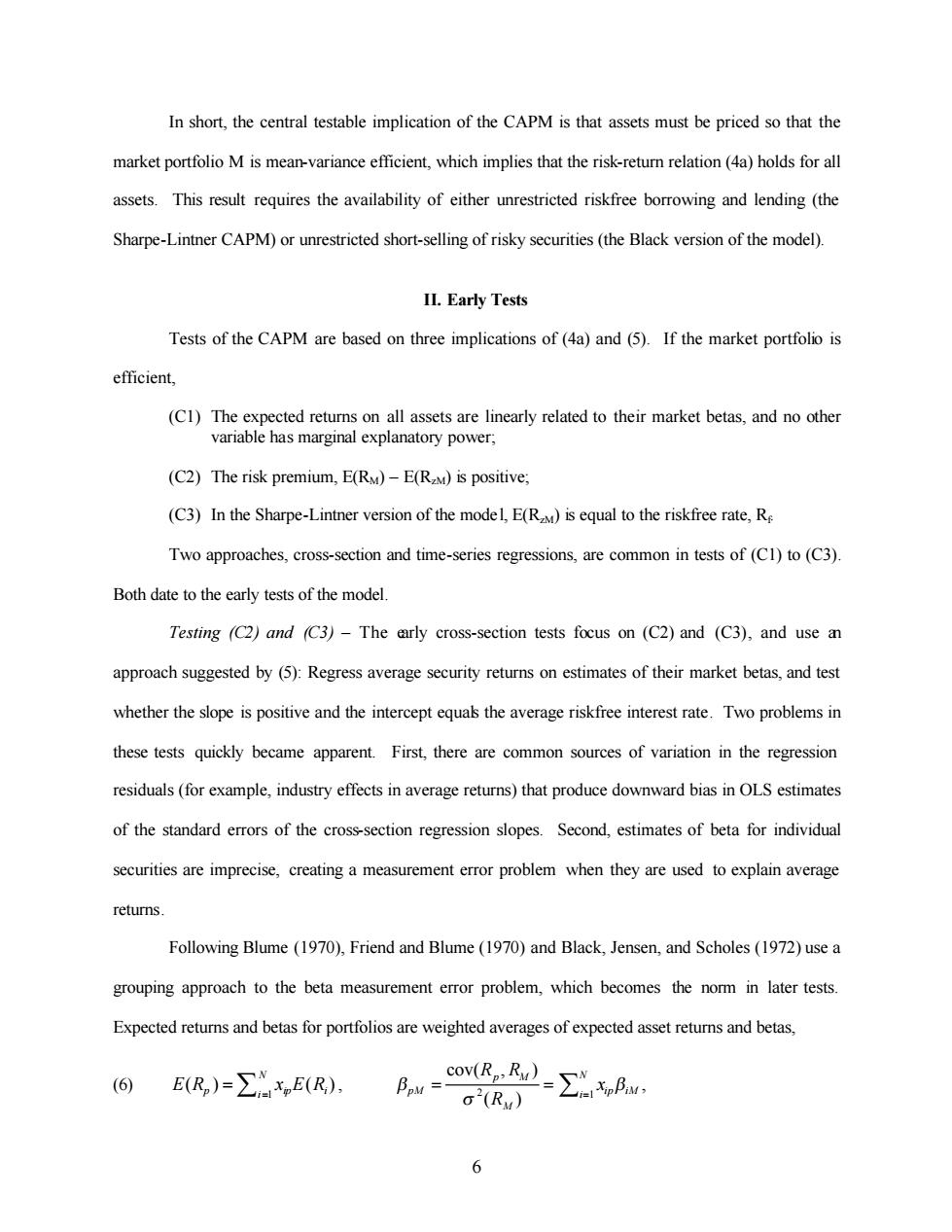正在加载图片...

In short,the central testable implication of the CAPM is that assets must be priced so that the market portfolio M is mean-variance efficient,which implies that the risk-return relation(4a)holds for all assets.This result requires the availability of either unrestricted riskfree borrowing and lending (the Sharpe-Lintner CAPM)or unrestricted short-selling of risky securities(the Black version of the model). II.Early Tests Tests of the CAPM are based on three implications of(4a)and(5).If the market portfolio is efficient, (C1)The expected returns on all assets are linearly related to their market betas,and no other variable has marginal explanatory power; (C2)The risk premium,E(RM)-E(RM)is positive; (C3)In the Sharpe-Lintner version of the model,E(RM)is equal to the riskfree rate,Re Two approaches,cross-section and time-series regressions,are common in tests of(C1)to (C3). Both date to the early tests of the model. Testing (C2)and (C3)-The early cross-section tests focus on (C2)and (C3),and use a approach suggested by (5):Regress average security returns on estimates of their market betas,and test whether the slope is positive and the intercept equals the average riskfree interest rate.Two problems in these tests quickly became apparent.First,there are common sources of variation in the regression residuals(for example,industry effects in average returns)that produce downward bias in OLS estimates of the standard errors of the cross-section regression slopes.Second,estimates of beta for individual securities are imprecise,creating a measurement error problem when they are used to explain average returns Following Blume (1970),Friend and Blume(1970)and Black,Jensen,and Scholes(1972)use a grouping approach to the beta measurement error problem,which becomes the norm in later tests. Expected returns and betas for portfolios are weighted averages of expected asset returns and betas, (6) E(R,)=∑x,E(R, A-g2-Σ G(Ru) 66 In short, the central testable implication of the CAPM is that assets must be priced so that the market portfolio M is mean-variance efficient, which implies that the risk-return relation (4a) holds for all assets. This result requires the availability of either unrestricted riskfree borrowing and lending (the Sharpe-Lintner CAPM) or unrestricted short-selling of risky securities (the Black version of the model). II. Early Tests Tests of the CAPM are based on three implications of (4a) and (5). If the market portfolio is efficient, (C1) The expected returns on all assets are linearly related to their market betas, and no other variable has marginal explanatory power; (C2) The risk premium, E(RM) – E(RzM) is positive; (C3) In the Sharpe-Lintner version of the model, E(RzM) is equal to the riskfree rate, Rf . Two approaches, cross-section and time-series regressions, are common in tests of (C1) to (C3). Both date to the early tests of the model. Testing (C2) and (C3) – The early cross-section tests focus on (C2) and (C3), and use an approach suggested by (5): Regress average security returns on estimates of their market betas, and test whether the slope is positive and the intercept equals the average riskfree interest rate. Two problems in these tests quickly became apparent. First, there are common sources of variation in the regression residuals (for example, industry effects in average returns) that produce downward bias in OLS estimates of the standard errors of the cross-section regression slopes. Second, estimates of beta for individual securities are imprecise, creating a measurement error problem when they are used to explain average returns. Following Blume (1970), Friend and Blume (1970) and Black, Jensen, and Scholes (1972) use a grouping approach to the beta measurement error problem, which becomes the norm in later tests. Expected returns and betas for portfolios are weighted averages of expected asset returns and betas, (6) 1 ( ) ( ) N p ip i i E R xER = =å , 2 1 cov( , ) , ( ) p M N pM i ip iM M R R x R b b s = = = å